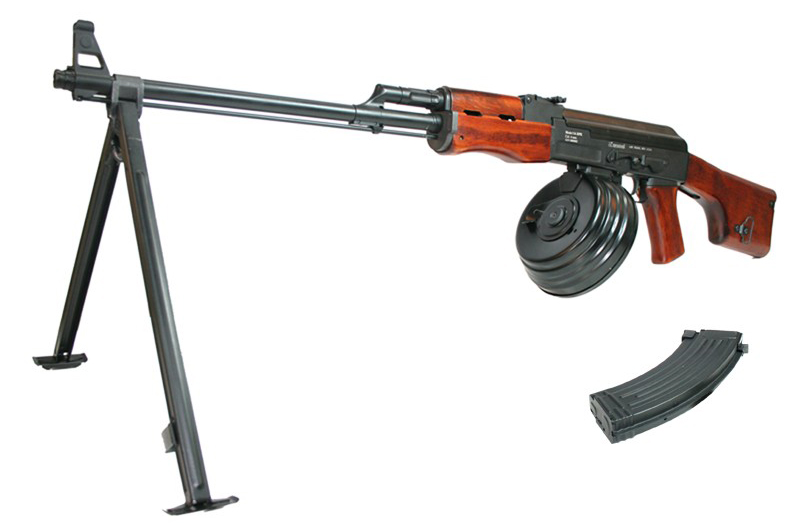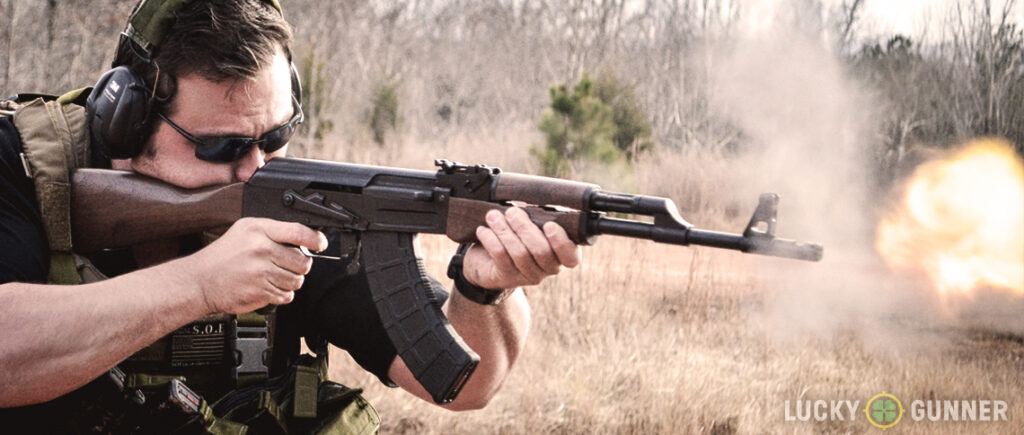One out of five firearms in the world is an AK of some kind. Books have been written about what a great rifle it is, and they are right. If you live in a free state that allows you to keep and bear one, you should. I’ve been shooting them, professionally building and modifying them, fixing them, and just appreciating them for about fifteen years now.
Whether you have an AK now, or you’re looking to add one to your gun rack, there are a few common AK mistakes and pitfalls that you should be aware of. They are easy enough to avoid, and you’ll save some money and annoyance if you keep them in mind.
1. Attaching a bipod to the end of the barrel
The RPK light machine gun is one of the coolest looking AK variants out there. Its long 23 inch barrel looks beefy and snipery (snipery is a word, right?), and oftentimes shooters purchase an RPK type hoping for increased velocity due to the barrel length (absolutely true) and increased accuracy as well (absolutely false).

Under the best of circumstances, the RPK is no more accurate than a standard AKM. Sorry, it just isn’t. When you put the RPK on its big bipod, which mounts to the very end of the muzzle, the bipod holds the muzzle still and the barrel basically sags in a banana shape, imperceptibly to the naked eye.
Shooting from a deployed bipod can result in a point of impact roughly four inches higher at 100 yards than shooting the same gun from sandbags. Shoot fast enough to get the barrel hot and the rounds start to “walk” even higher. Increase the range and the disparity grows.
If you have an RPK, decide whether you want to shoot it exclusively from the bipod or exclusively without the bipod deployed, and sight it in accordingly. Be ready to compensate for vertical stringing as the barrel heats up. Or, you know, you could just rapid fire and walk your rounds onto that milk jug after you see where the first couple of shots landed. Nobody has to know.
In combat, the RPK gunners have used a lot of tracer rounds to improve their aiming abilities as barrel temperatures and engagement ranges vary during the firefight. Putting a bipod on the end of a standard AK barrel invites the same exact problems, but to a lesser extent due to the decrease in barrel length. My advice on putting a bipod on your AK? Don’t!
2. Poorly placed forward pistol grips
There have been a lot of AK variants with forward pistol grips, and most of them suffer from the same problem: they interfere with the “rock in” magazine design. The AK requires the user to tilt the bottom of the magazine forward to insert the front tab into the mag well notch, before snapping the magazine body rearwards to lock the rear tab into the mag catch. It’s actually a very strong and robust system, although not the fastest to reload.
Fast reloading is made exponentially harder if your magazine, or the hand holding it, runs into a forward pistol grip hanging right where the magazine arcs. It doesn’t make mag changes impossible, it just makes them more problematic, and mag changes are an area where the AK already lags behind compared to other systems like the AR-15.
For this reason, I think the Magpul AFG or a small hand-stop setup is a natural choice for the AK if you decide to put some sort of grip enhancing device on the forend. Keep forward pistol grips short and mounted forward on your fighting Kalashnikov.
3. Over-polishing the fire control group
People often ask me what they can do to accurize their AK rifle. The answer is simple: install a better trigger, shoot high quality 7.62×39 ammunition, and slow down. The Kalashnikov trigger is decent for a fully automatic military rifle designed almost 70 years ago, but it’s hardly “match grade” quality. I’ve seen more than one amateur gun smith pull out Ye Olde Dremel Tool and polish the heck out of the very generous mating surfaces on the hammer and trigger hooks in an attempt to smooth that trigger out.
While this plan may actually work to smooth things out, it does nothing to alleviate the physically long pull and reset, and the weight of the trigger itself. Worse, I’ve encountered user-polished fire control groups that were ruined because the polishing process cut through the surface hardening and exposed the relatively soft steel underneath. You’ll get a trigger that feels better for a few magazines, then gets suddenly worse as it peens itself to death inside the receiver. Malfunctions follow, and suddenly your friends are teasing that “I thought those things were supposed to be reliable, har har!”
Skip the homegrown polishing routine — it just isn’t worth it on this particular gun. Buy an adjustable 2-stage trigger from Red Star Arms, follow the instructions included, and enjoy an AK that will be more enjoyable to shoot for years to come. If a 2-stage isn’t your thing, look at the single stage AKT trigger made by ALG Defense.
4. Converting a single stack magazine AK to accept standard magazines
AKs built to take a ten-round single stack magazine are cheaper for a reason. I’ve often seen shooters trying to get the best possible deal outsmart themselves by buying a relatively cheap single stack, bringing it over to their local gunsmith (me), wanting to “hog out that mag well” to accept standard magazines. This is a bad idea for two reasons.
First, the physical task involves placing the receiver in a milling machine and removing metal from the receiver and also the front trunnion underneath it. The trunnion is the part that’s held onto the receiver with rivets, and it holds the barrel in place. Its dimensions are critically important and cutting a bunch of it away correctly is time consuming.
After you’re done with the milling machine, you must create a notch for the front of the magazine to lock into. If there isn’t enough metal left up there after the milling operation, out comes the welder to “create” some more metal for us. The notch must then be cut in a perfect location. Too high or too low and you’ll have terrible feeding problems. Oh, and if the gun is a Yugoslavian N-PAP single stack, its bolt is made differently to work with the thin single stack magazine, so all this is probably for nothing anyway. By the time you’ve paid a gunsmith for all the labor he expended converting your gun, guess what you could have bought instead? But that’s only half the issue.
The other issue is that the imported single stack guns contain no US parts. They are configured to comply with the import regulations that banned “assault weapons” from being imported almost 25 years ago. Skipping the law lecture, the way to legally own an AK with original features is to ensure that it has no more than ten imported parts from a list of sixteen total parts. Because single stack AKs have no US made parts at all, to make your conversion legal you’ll have to replace six imported components with US made components. Even if you have the skills and machinery to do the physical conversion yourself, you’ll lose money making your conversion legal compared to just buying the type of rifle you really wanted in the first place. The only reason to buy a single stack AK is if you live in a state that outright bans standard capacity magazines.
5. Not cleaning and lubricating your Kalashnikov
“But wait!” the internet says. “The Kalashnikov is indestructible! I saw this one video where they ran over it with a Russian army truck! And I saw this other video where they filled it with sand, and my uncle knows a guy who hasn’t cleaned his AK for 30 years…”
Ok, settle down. I saw the videos too. I may even have participated in some of them. They prove that the rifle is very tough indeed. I’ve also seen the Glock 21 that still worked after being shot by another gun, and I’ve seen the car engines that ran for impressive lengths with no oil in them during the insanity known as “Cash for Clunkers.” So what? Just because a machine can withstand neglect and abuse well doesn’t mean that we should abuse it.
African fighters have lubricated their AKs with discarded motor oil, using a knot tied in their boot laces as a barrel pull through. But making do with what you have on hand isn’t the same thing as making a choice to neglect your machine. I guarantee those combatants, depending on their rifles for survival, would much rather have access to a proper cleaning kit and specially formulated gun lubricant. The American shooter is spoiled with the availability of excellent specialty gun care products. Pick one and use it to prevent rust, and lubricate the parts of the gun that rub together when it shoots.
The AK is a solid rifle when rusting in the jungle or choking on sand in the desert. Maintaining it properly makes the Kalashnikov the best rifle it can be. Why wouldn’t you want that?

